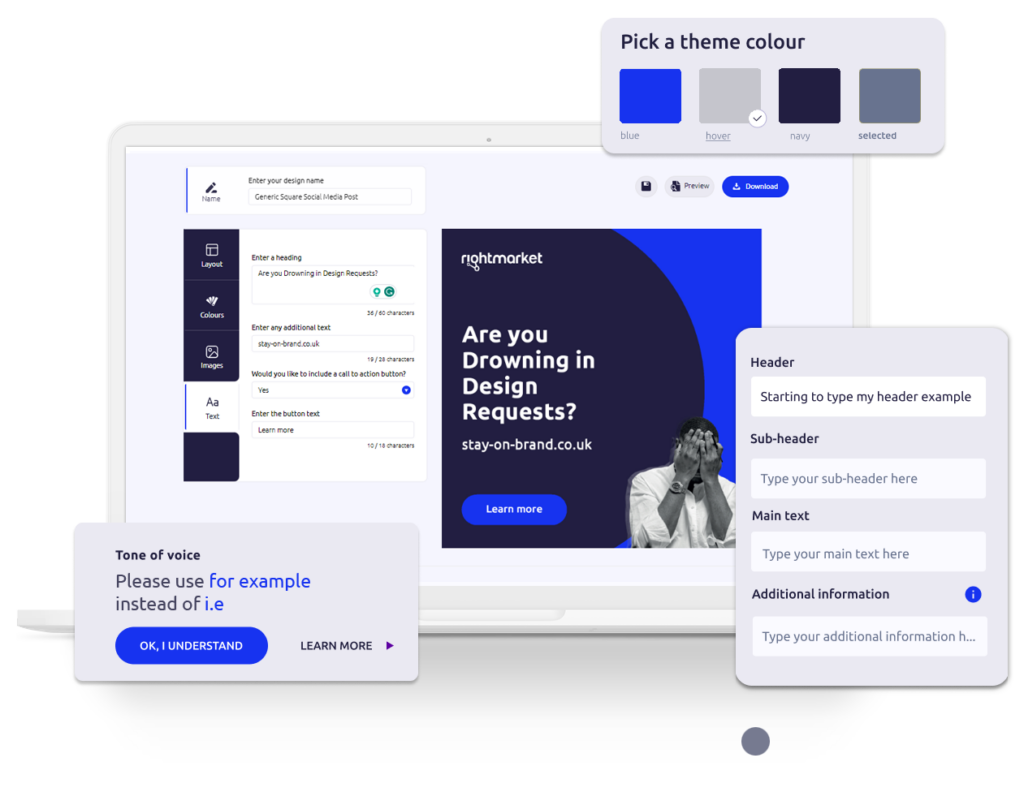Reimagining brand consistency: Why and how to integrate AI into your brand guidelines
Key takeaways
- Strategic integration of AI: Incorporating AI into brand guidelines helps brands to control it’s usage, enhancing personalised interactions and insights while ensuring brand integrity.
- Consistency and authenticity maintenance: Updating brand guidelines for AI use is crucial to maintaining brand consistency and authenticity across all touchpoints.
- Adaptation to technological advances: Brands must adapt their guidelines to keep pace with advancements, ensuring competitiveness and coherence in a tech-driven marketplace.
- Ethical considerations and brand trust: Ethical use and data privacy are paramount, requiring guidelines that ensure transparency and maintain customer trust.
- Dynamic and collaborative guideline development: Developing AI-integrated brand guidelines demands a dynamic, collaborative approach to cover all AI aspects and foster innovation within brand boundaries.
Artificial intelligence (AI) has been bubbling away in the background for years until the launch of ChatGTP in November 2022. It erupted with such a force that it’s disrupted nearly every aspect of our working life, seemingly overnight, reshaping how we work and how brands interact with their audiences.
ChatGTP saw the fastest adoption rate in history as it enabled anyone with internet access free use of its Large Language Model (LLM) and others quickly followed. What exactly are LLMs? They’re trained on datasets from numerous sources to be able to carry out a wide range of tasks. Anything from answering questions, translating language, analysing data, writing letters and more.
From personalised marketing campaigns to automated customer service, AI’s capabilities are not just enhancing operational efficiencies but also redefining brand experiences. The impact that it’s having on every aspect of brand identity and consistency is clear and progressive brands are beginning to react. However, integrating AI into branding can be challenging, it requires a thoughtful approach that supports consistency, authenticity, and alignment with brand values.
In this article, we’re going to be outlining the growing importance of incorporating AI into brand guidelines. How it can provide organisations with a strategic framework to harness AI’s potential while protecting brand integrity. Through expert insights, examples, and practical recommendations, we aim to guide brands in navigating the complexities of AI integration, ensuring they remain competitive and coherent in a technology-driven marketplace.

The Rise of AI in Branding
The adoption of AI in branding is not just a trend but a transformative shift. Its usage ranges from generating ideas that spark creativity in strategy, to analysing vast amounts of data to understand consumer behaviour and help predict market trends. It has created an indispensable tool for brands aiming to stay relevant and competitive. The rise of AI in branding can be attributed to several key factors and its implications are far-reaching.
For example, AI-driven analytics tools can analyse customer feedback across social media platforms, providing brands with insights into consumer sentiment and emerging trends. This capability enables brands to tailor strategies and communications in real time, helping to create a deeper connection with their audience.
AI can bring some amazing benefits to brand and marketing;
| Benefit | Application | Outcome |
|---|---|---|
| Personalisation | Personalisation at scale delivering personalised content, recommendations, and experiences etc. | Enhancing customer satisfaction and loyalty. |
| Enhanced customer insights | Analysing customer preferences, behaviours, feedback and other data in real time. | The ability to gain insights to adjust and adapt strategies quickly and efficiently. |
| Streamlining content creation | Automating routine tasks and providing frameworks for more complex content strategies. | Automating routine tasks and providing frameworks for more complex content strategies. |
| Innovating brand experiences | Create unique brand experiences, from AI-powered chatbots that offer 24/7 customer service to virtual try-ons and interactive experiences. | Enables brands to engage with their customers in innovative ways, setting new standards for customer interaction. |
However, as with any technology, there is a dark side and in this case, ethical considerations need to be made.
Example: AI-Powered personalisation
Let’s consider “EduTech Innovations,” a hypothetical educational technology company dedicated to enhancing learning experiences through technology.
EduTech Innovations decides to incorporate AI into their brand guidelines to ensure that all AI-driven communications, from automated email responses to virtual assistants, maintain the brands tone of voice. Understanding the importance of a consistent tone of voice across all customer touchpoints, EduTech outline specific AI usage parameters within their brand guidelines.
The revised guidelines detail how AI should be used in creating educational content and imagery. Any text generated using AI should be informative, engaging, and accessible, while the imagery should be created from a colour scheme that’s vibrant yet soothing. This mirrors the company’s commitment to making learning enjoyable and effective for all age groups, aiming to encourage a positive learning environment.
Going one step further, they also outlined ethical considerations, emphasising the importance of transparency in AI’s role in content creation and interaction. This included directives for AI to prompt user consent where personalisation was applied, aligning with the company’s values around privacy and trust.
Through these AI-integrated brand guidelines, EduTech Innovations streamlines content production and customer service processes, ensuring that all AI-enhanced interactions and materials are efficient, personalised and consistently reflecting the brand’s ethos and commitment to an enriching educational experience. This strategic move bolstered the company’s reputation for innovation while maintaining a strong, unified brand identity.
Implications for brand strategy
All this is a push for organisations to re-evaluate brand strategies, to incorporate AI technologies effectively. So, to maintain consistency adaptive brands should develop AI-integrated brand guidelines which are aligned with their ethical standards and assist to maintain brand identity and customer engagement.
The integration of AI in branding will only deepen, with it becoming a key driver of brand innovation and customer experience. Brands that successfully embedded it into their strategies and guidelines, will be ahead of the curve and in a better position to adapt.
Importance of AI integration into brand guidelines
The dynamic capabilities of AI mandate its inclusion in brand guidelines. As it creates content, interacts with customers, and represents the brand, its alignment with the brand’s identity is crucial. If it’s left out in the cold, there’s a risk of inconsistent experiences for customers, potentially damaging loyalty and trust. Integrating it into brand guidelines ensures a unified brand voice and visual identity across all channels, enhancing the brand. Left unchecked for too long unfavourable behaviours within your communication-producing, non-marketing/design/production workforce will begin to develop.
| It should | Why? |
|---|---|
| Ensure brand consistency across AI driven platforms | The number of AI touchpoints between brand and customers is increasing which threatens the established tone of voice or visual identities. This can lead to a fragmented brand experience. |
| Leverage AI for personalised customer experiences | It’s ability to analyse data and tailor content to individual preferences offers unparalleled opportunities for personalized marketing. |
| Mitigate risks and ensure the ethical use of AI | The potential for ethical pitfalls increases, from privacy concerns to the risk of bias in AI algorithms. |
| Foster innovation within brand boundaries | There are many opportunities for innovation in product development, marketing, and customer service, however, innovation without direction can dilute brand identity. |
| Prepare for the future of branding | It prepares brands for future advancements, ensuring they can adapt to new technologies while maintaining a consistent brand identity. |

Challenges without AI-integrated brand guidelines
Lack of AI integration in brand guidelines can lead to several issues:
- Inconsistency in messaging and tone of voice: AI-generated content that doesn’t align with the brand’s established tone of voice can confuse customers.
- Brand Dilution: Unchecked AI applications might produce content that dilutes the brand’s unique identity.
- Missed opportunities: It could be underutilised, misapplied, or invested in areas that offer little alignment with the brand’s core values and goals, missing opportunities for personalisation, engagement, efficiency and innovation.
- Ethical and privacy concerns: Without guidelines, AI might inadvertently breach ethical boundaries, affecting customer trust.
Benefits of AI-integrated brand guidelines
The integration of AI into brand guidelines brings numerous benefits, including:
- Consistent brand experience: Ensures all AI-generated content across all touchpoints aligns with the brand’s tone of voice and visual identity.
- Enhanced efficiency: Streamlines content ideation, creation and distribution as well as customer engagement processes.
- Personalisation: Enables personalisation of a scale that’s not been seen before delivering tailored experiences to individual customers enhancing engagement and loyalty.
- Informed decision-making: Leveraging AI for data-driven insights into brand strategy and customer preferences.
- Agile response to market changes: Through the insights it provides it empowers brands to be agile, adapting their strategies in real-time based on predictive analytics.
Key components of AI-integrated brand guidelines
Ethical AI use
First and foremost guidelines should mandate the ethical use of AI, emphasising data privacy, bias avoidance, and transparency. This ensures AI applications respect customer rights and reflect the brand’s values.
Content creation
It should define the extent that AI should be used in content creation. It’s a good tool to assist in research, generate ideas, and suggest content frameworks. However, the final content should be developed and approved by humans to maintain tone of voice and authenticity which helps to develop and sustain trust and loyalty.
Visual identity
Outline how AI can suggest designs however emphasise the need for human oversight in finalising visual content. All visuals need to adhere to this aspect of the brand’s guidelines so they shouldn’t go unchecked.
Approval processes and controls
Establish clear processes for reviewing AI-suggested content and designs. You can implement approval processes or use tools that have tone of voice controls like the RightMarket tone of voice assistant to help you keep it in check.
Transparency Requirements
Building brand trust takes time and money, however, it can be destroyed in mere moments. Transparency when using AI is key to maintaining brand trust. Specify when and how to communicate the involvement of AI in content generation.

How to implement AI into brand guidelines
Implementation involves a thorough assessment of current guidelines, identification of areas where AI can add value and where it’s already being used and update the guidelines accordingly. Training team members on AI tools and ethical considerations is crucial, establishing a feedback loop to continuously refine AI applications in branding. We would recommend the following steps;
Step 1: Assess current brand guidelines
Review your current brand guidelines to understand how they address digital technologies and automated processes. Identify any gaps that don’t account for the use of AI for creating content, for example automated social media posts, customer service responses, or personalised content marketing.
Step 2: Define AI integration objectives
Understand what you want to achieve by integrating AI into your brand guidelines, is it enhancing customer experience, streamlining content creation, or improving data analysis for marketing strategies? From that you can ensure that your objectives for AI integration complement your overall brand strategy while maintaining your brand.
Step 3: Develop AI-specific guidelines
Ensure that the guidelines are clear in the following areas;
- Ethical AI use: Ensure AI technologies are used in a way that aligns with ethical considerations, such as data privacy and bias avoidance.
- Content creation: Be specific about how it can be used to create content, including the types of content AI is allowed to generate. Can it only be used to create ideas, or can it create entire content pieces? Set standards for maintaining brand tone of voice and messaging.
- Visual identity: Outline how it’s use should adhere to your brand’s visual identity, including the use of logos, colour schemes, and imagery.
- Approval processes: Establish processes for reviewing and approving AI-generated content to ensure it meets brand standards before being published.
- Transparency requirements: Define when and how to disclose the use of AI in content creation and customer interactions.
Step 4: Train your team
It’s a good idea to provide training for your marketing, design, and content teams on the capabilities and limitations of AI technologies. It helps all relevant team members to familiarise themselves with the new AI-integrated guidelines and understand how to apply them in their work.
Step 5: Implement monitoring and evaluation processes
Implement a monitoring process to ensure AI-generated content and interactions adhere to the new guidelines. Regular assessments of the impact of AI on your brand’s engagement, consistency, and efficiency will help you to understand how the guidelines will need to adapt. Gather feedback from both customers and internal teams.
Step 6: Update guidelines regularly
Periodically review the AI-specific guidelines to ensure they remain relevant and effective as AI technologies evolve.
Future Trends and Considerations

As AI continues to reshape every facet of our lives, the future looks towards embracing rapid innovation while upholding ethical standards.
The drive towards hyper-personalisation will see AI crafting unique customer experiences, from content right down to products and services, all tailored in real-time. Simultaneously, the emergence of voice and visual search, along with AR and VR technologies, promises to offer more intuitive and immersive brand interactions, making every engagement an adventure in itself. We can see evidence of this in Coca Cola’s interactive AR experience which, in our opinion, is a great piece of brand storytelling.
Yet, as the development and use of this technology advances, the ethical use, and the safeguarding of data privacy is paramount. Brands are called to champion transparency and fairness, ensuring its power is harnessed responsibly, with a keen eye on eliminating biases and clarifying data use to consumers. We don’t want to see more examples of its use to deceive for financial gain, for example the Willy Wonka Chocolate Experience held (or not held) on the 24 February 2024.
Facing these advancements, brands must implement dynamic, forward-thinking guidelines that evolve alongside AI’s rapid development. This requires a collaborative effort, bridging marketing, legal, technology, and ethics, to create guidelines that not only embrace innovation but also engender authenticity and trust.
As brands venture into global markets, the complexity of cultural sensitivities and regional regulations will require adaptable strategies that honour global diversity while ensuring local relevance. AI is not just a tool for operational efficiency but a catalyst for meaningful innovation and growth, offering brands a chance to deepen customer connections and stay ahead in an ever-evolving digital landscape.
My final note: In the interest of transparency the structure of this article was created with the help of AI. The FAQs are produced entirely by AI.
Find out how RightMarket can enhance your brand with Project Discovery.
Visit us to learn more about this value-driven service and how it can illuminate the path to greater brand efficiency and impact.
Let’s explore the possibilities together.
FAQs
Why is it important to incorporate AI into brand guidelines?
As AI becomes increasingly integrated into marketing and branding efforts, having clear guidelines ensures that AI-generated content aligns with your brand’s identity, values, and messaging standards, maintaining consistency and integrity across all platforms.
Can AI replace creative teams in content creation?
No, AI should be viewed as a tool that augments and supports the creative process. It can provide insights, suggest content frameworks, and automate repetitive tasks, but the creativity, strategy, and final decisions should rest with human teams to ensure content resonates on a personal level with audiences.
How do you ensure AI-generated content adheres to brand guidelines?
Establish specific guidelines for tone, style, and messaging for AI-generated content. Use AI tools that allow for customization to your brand’s standards and implement review processes where human oversight ensures content aligns with your brand guidelines before publication.
What are the ethical considerations when using AI in branding?
Ethical considerations include ensuring data privacy, avoiding bias in AI-generated content, respecting copyright laws, and being transparent about the use of AI where necessary. Your brand guidelines should reflect these ethical commitments.
How often should brand guidelines be updated to reflect advancements in AI?
Brand guidelines should be reviewed regularly, at least annually, to consider the latest AI advancements and their implications for your brand strategy. This ensures your guidelines remain relevant and effective in guiding AI use in your branding efforts.
How can small businesses without large tech teams incorporate AI into their brand guidelines?
Small businesses can leverage AI tools designed for non-technical users that still adhere to brand guidelines. Focus on AI applications that offer the most value, such as content idea generation or customer data analysis, and seek out AI tools that provide user-friendly guidance and support.
What steps should be taken if AI-generated content violates brand guidelines?
Establish a clear protocol for addressing violations, which may include immediate content removal, review of the AI tool’s settings, retraining AI models if applicable, and revising guidelines to prevent future issues. It’s important to learn from these instances to refine both the AI application and the guidelines themselves.
Can AI help in monitoring brand consistency across digital platforms?
Yes, AI can analyse content across various platforms to ensure consistency with brand guidelines. These tools can flag discrepancies, helping brands maintain a cohesive presence online.